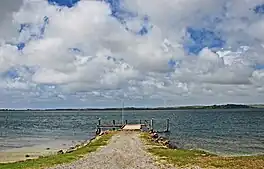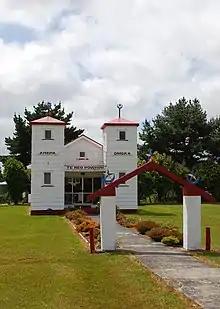Te Hāpua | |
|---|---|
 Te Hapua Wharf | |
| Coordinates: 34°31′2″S 172°54′45″E / 34.51722°S 172.91250°E | |
| Country | New Zealand |
| Region | Northland Region |
| District | Far North District |
| Ward | Te Hiku |
| Electorates | |
| Government | |
| • Territorial Authority | Far North District Council |
| • Regional council | Northland Regional Council |
Te Hāpua is a community on the shores of the Parengarenga Harbour in Northland, New Zealand. The road to Te Hāpua leaves State Highway 1 at Waitiki Landing.[1]
Te Hāpua is the most northerly settlement in New Zealand. The 2013 Census recorded 84 people in the Te Hapua region.[2]
The New Zealand Ministry for Culture and Heritage gives a translation of "the lagoon" for Te Hāpua.[3]
Matiu Rata, Cabinet Minister in the Third Labour Government in the 1970s and founder of the Mana Motuhake party, was born in Te Hāpua in 1934.[4]
The 1975 Māori land march left Te Hāpua for Wellington on 14 September 1975 (Maori Language Day).[5]
Te Hāpua's Te Reo Mihi Marae is a traditional meeting ground for Ngāti Kurī,[6] and includes Te Reo Mihi meeting house.[7]
Demographics
Te Hāpua is in an SA1 statistical area which covers 285.49 km2 (110.23 sq mi)[8] and includes the area north of Waitiki Landing. The SA1 area is part of the larger North Cape statistical area.[9]
| Year | Pop. | ±% p.a. |
|---|---|---|
| 2006 | 165 | — |
| 2013 | 144 | −1.93% |
| 2018 | 141 | −0.42% |
| Source: [10] | ||
The SA1 statistical area had a population of 141 at the 2018 New Zealand census, a decrease of 3 people (−2.1%) since the 2013 census, and a decrease of 24 people (−14.5%) since the 2006 census. There were 60 households, comprising 75 males and 66 females, giving a sex ratio of 1.14 males per female. The median age was 48.1 years (compared with 37.4 years nationally), with 24 people (17.0%) aged under 15 years, 30 (21.3%) aged 15 to 29, 69 (48.9%) aged 30 to 64, and 21 (14.9%) aged 65 or older.
Ethnicities were 14.9% European/Pākehā, 89.4% Māori, 6.4% Pacific peoples, and 2.1% Asian. People may identify with more than one ethnicity.
Of those people who chose to answer the census's question about religious affiliation, 12.8% had no religion, 14.9% were Christian and 63.8% had Māori religious beliefs.
Of those at least 15 years old, 3 (2.6%) people had a bachelor or higher degree, and 54 (46.2%) people had no formal qualifications. The median income was $16,200, compared with $31,800 nationally. The employment status of those at least 15 was that 36 (30.8%) people were employed full-time, 21 (17.9%) were part-time, and 12 (10.3%) were unemployed.[10]
Education
Te Hāpua School is a coeducational full primary (years 1–8) school with a decile rating of 1 and a roll of 18.[11] It is New Zealand's northernmost school.
Climate
Te Hapua has a temperature oceanic climate (Cfb according to the Köppen climate classification), like much of New Zealand, with warm summers, mild winters and no dry season. The average annual temperature is 16.4 °C (61.5 °F), the annual average high temperature is 20.2 °C (68.4 °F) and the annual average low temperature is 12.7 °C (54.9 °F). The warmest month in Te Hapua is February, with a mean of 20.7 °C (69.3 °F) and an average high of 24.9 °C (76.8 °F). The coolest months are July and August, with a mean of 12.9 °C (55.2 °F) for both months. Due to its maritime location, the ocean moderates temperatures year-round, and there is some seasonal lag.
Te Hapua receives 998 millimetres (39.3 in) of precipitation each year. Although there is no dry season, winter is usually wetter than summer. The wettest month is July, which receives 116.0 millimetres (4.57 in) of precipitation each year, while the driest month is January, which receives 61.0 millimetres (2.40 in) of precipitation.
| Climate data for Te Hāpua, Northland, 4 m | |||||||||||||
|---|---|---|---|---|---|---|---|---|---|---|---|---|---|
| Month | Jan | Feb | Mar | Apr | May | Jun | Jul | Aug | Sep | Oct | Nov | Dec | Year |
| Mean daily maximum °C (°F) | 24.4 (75.9) |
24.9 (76.8) |
23.4 (74.1) |
21.4 (70.5) |
19.1 (66.4) |
17.1 (62.8) |
16.4 (61.5) |
16.5 (61.7) |
17.5 (63.5) |
18.7 (65.7) |
20.3 (68.5) |
22.5 (72.5) |
20.2 (68.4) |
| Daily mean °C (°F) | 20.3 (68.5) |
20.7 (69.3) |
19.4 (66.9) |
17.6 (63.7) |
15.4 (59.7) |
13.6 (56.5) |
12.9 (55.2) |
12.9 (55.2) |
13.9 (57.0) |
15.1 (59.2) |
16.7 (62.1) |
18.5 (65.3) |
16.4 (61.5) |
| Mean daily minimum °C (°F) | 16.2 (61.2) |
16.5 (61.7) |
15.4 (59.7) |
13.9 (57.0) |
11.8 (53.2) |
10.1 (50.2) |
9.4 (48.9) |
9.3 (48.7) |
10.3 (50.5) |
11.6 (52.9) |
13.1 (55.6) |
14.6 (58.3) |
12.7 (54.9) |
| Average precipitation mm (inches) | 61.0 (2.40) |
65.0 (2.56) |
75.0 (2.95) |
95.0 (3.74) |
85.0 (3.35) |
115.0 (4.53) |
116.0 (4.57) |
107.0 (4.21) |
88.0 (3.46) |
66.0 (2.60) |
63.0 (2.48) |
62.0 (2.44) |
998.0 (39.29) |
| Source: Climate-data.org[12] | |||||||||||||

Notes
- ↑ Peter Dowling, ed. (2004). Reed New Zealand Atlas. Reed Books. pp. map 2. ISBN 0-7900-0952-8.
- ↑ Harris, Sarah (14 May 2015). "Living in Te Hapua". Stuff. Retrieved 23 May 2021.
- ↑ "1000 Māori place names". New Zealand Ministry for Culture and Heritage. 6 August 2019.
- ↑ David Barber (28 July 1997). "Obituary: Matiu Rata". The Independent.
- ↑ Metge, Joan (2004). Rautahi: The Maoris of New Zealand. p. 112. ISBN 0415330572.
- ↑ "Te Kāhui Māngai directory". tkm.govt.nz. Te Puni Kōkiri.
- ↑ "Māori Maps". maorimaps.com. Te Potiki National Trust.
- ↑ "ArcGIS Web Application". statsnz.maps.arcgis.com. Retrieved 17 March 2022.
- ↑ 2018 Census place summary: North Cape
- 1 2 "Statistical area 1 dataset for 2018 Census". Statistics New Zealand. March 2020. 7000000.
- ↑ Education Counts: Te Hapua School
- ↑ "Climate Data for Cities Worldwide". openstreetmap.org. Retrieved 19 December 2019.